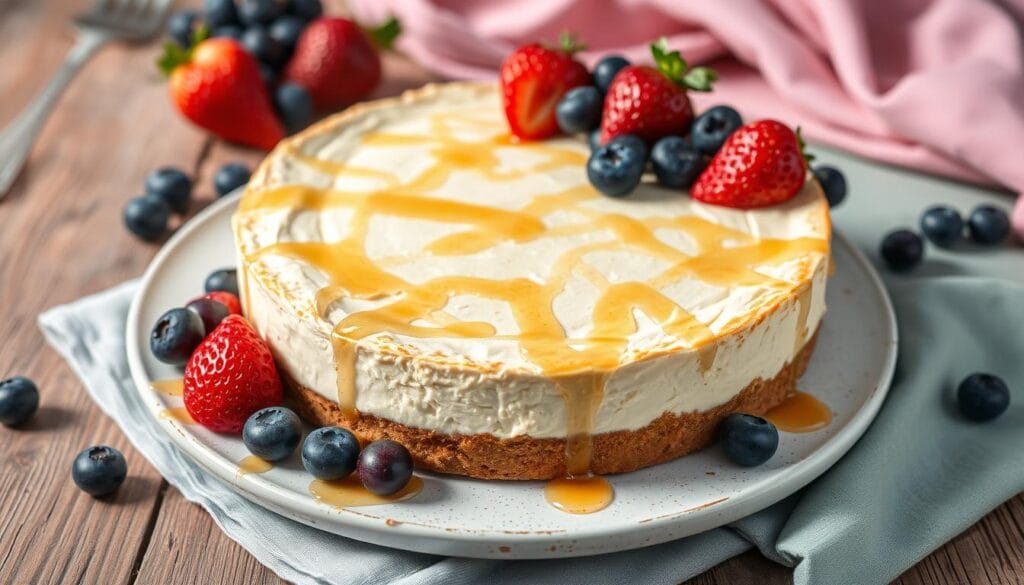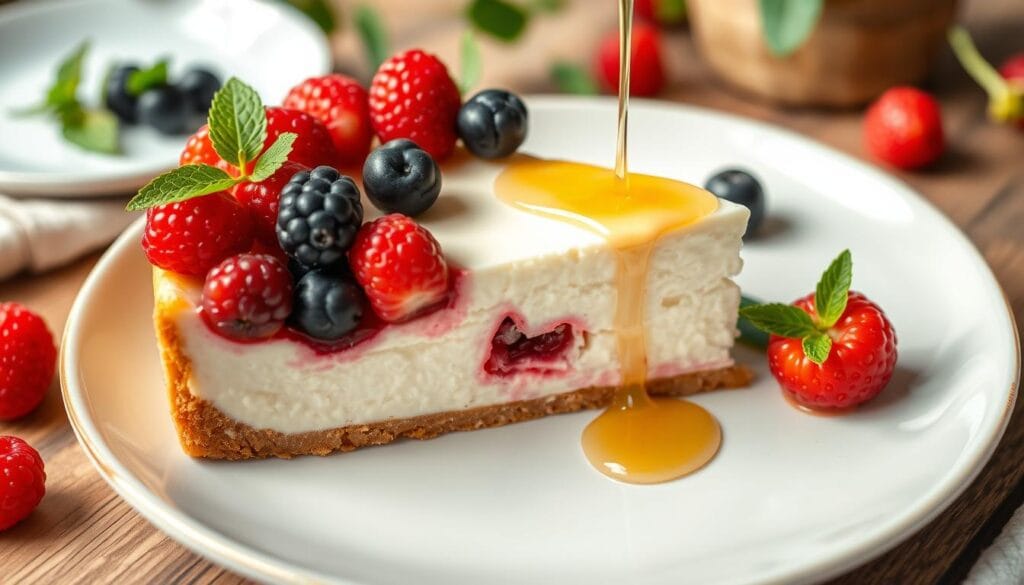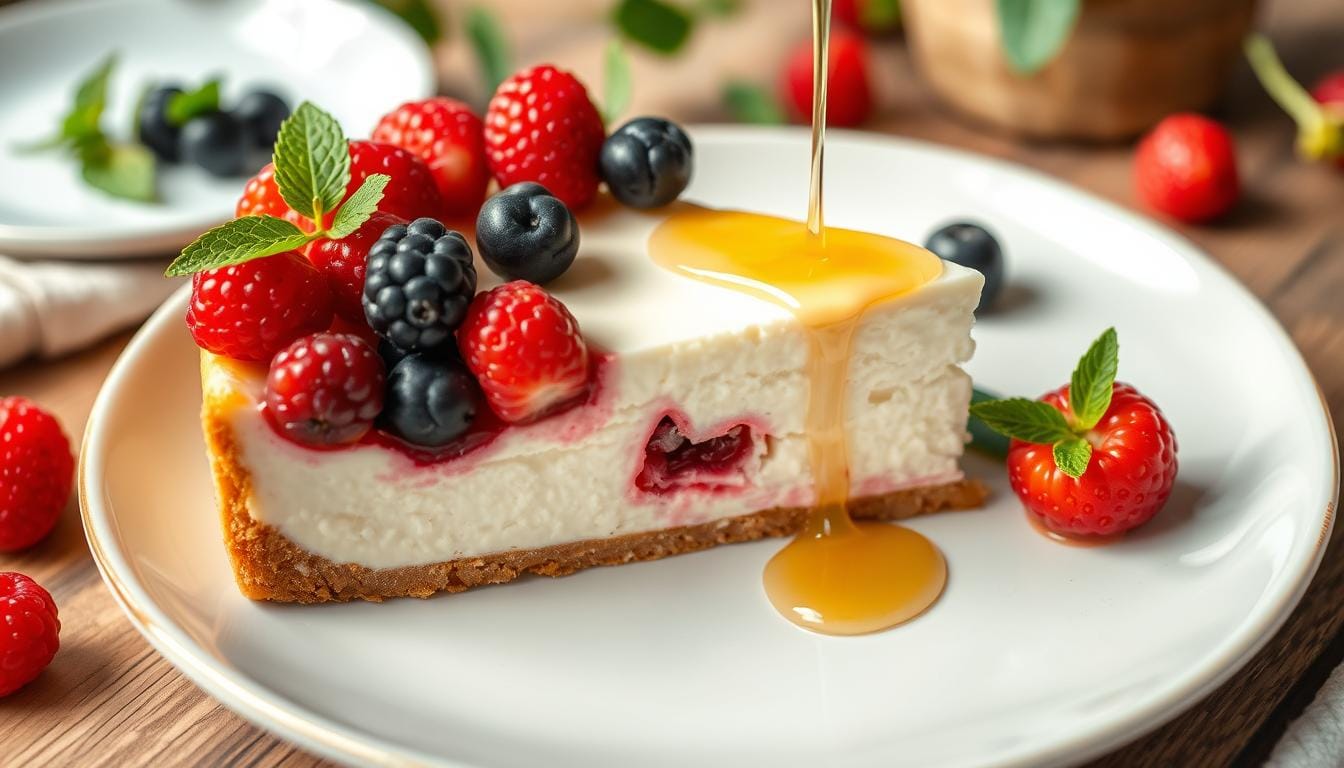Imagine enjoying a dessert that’s both tasty and healthy. Cottage cheese cheesecake is a great choice. It has about 205 calories, 12 grams of protein, and less sugar than regular cheesecakes. This makes it perfect for those who want a healthy dessert.

Table of Contents
Key Takeaways
- A single serving of cottage cheese cheesecake contains 205 calories and 12 grams of protein.
- Cottage cheese cheesecake is lower in calories, fat, and sugar compared to traditional cheesecake.
- The incorporation of high-protein cottage cheese supports muscle building and contains B vitamins, selenium, and calcium for bone strength.
- Cottage cheese provides 6% of the daily allowance of vitamin A, 20% of vitamin D, and 10% of calcium.
- A 2012 study showed that including cottage cheese in a weight loss diet can lead to reductions in LDL cholesterol and blood pressure levels.
- Cottage cheese cheesecake can be customized with added fruit, such as berries, and a homemade base made from low sugar granola or muesli.
Exploring cottage cheese cheesecake reveals its many health benefits and protein facts. It’s a tasty and nutritious option. If you’re searching for a healthy dessert or a unique cheesecake, cottage cheese cheesecake is a great choice.
What Makes Cottage Cheese Cheesecake Different
Cottage cheese cake is a special treat that’s both light and packed with protein. It’s unlike regular cheesecakes because of cottage cheese. This ingredient is rich in protein and low in fat, making it a healthier choice for dessert.
Try a cottage cheese mousse for a light and airy dessert. It’s a way to enjoy cottage cheese in a new way. You can make everything from a classic cottage cheese cake to a creamy mousse.

A cottage cheese cheesecake is perfect for those who want a healthier dessert. It’s high in protein and low in fat and sugar. So, whether you’re craving a classic cottage cheese cake or a creamy mousse, there’s something for everyone.
| Nutritional Benefit | Cottage Cheese Cheesecake | Traditional Cheesecake |
|---|---|---|
| Protein Content | 7 grams per serving | Less than 5 grams per serving |
| Fat Content | 7 grams per serving | 20 grams per serving |
| Sugar Content | 11 grams per serving | 20-30 grams per serving |
The Nutritional Powerhouse of Cottage Cheese Cake
Cottage cheese cake is a healthy protein dessert that’s packed with nutrients. It has lots of protein and not many calories, making it a great choice for a treat. A half-cup of cottage cheese has 81 calories and 14 grams of protein. This makes it perfect for healthy protein desserts like cottage cheese cheesecake.
Cottage cheese is full of important nutrients like calcium, phosphorus, and selenium. It also has vitamins B12 and B2. These nutrients make cottage cheese a great base for cottage cheese cake, adding protein and minerals to your dessert.
Here are some of the key nutritional benefits of cottage cheese:
- High protein content: 14 grams per half-cup serving
- Low calorie count: 81 calories per half-cup serving
- Rich in calcium, phosphorus, and selenium
- Good source of vitamins B12 and B2

Adding cottage cheese to your diet can help in many ways. It supports muscle growth and can help with weight management. With its nutritional benefits, cottage cheese is a great choice for making healthy protein desserts like cottage cheese cheesecake or cottage cheese cake.
Essential Ingredients for Your Protein-Rich Dessert
Making a cottage cheese dessert requires the right ingredients for a tasty and healthy treat. A cottage cheese cake is perfect for those seeking healthy protein desserts. First, pick the right cottage cheese.
Selecting the Right Cottage Cheese
The type of cottage cheese you choose affects your dessert’s taste and texture. Look for low-sodium, smooth cottage cheese. Mixing cottage cheese with nonfat Greek yogurt adds creaminess.
Additional Protein Boosters
Adding other protein-rich ingredients boosts your dessert’s nutrition. Eggs, cream, and vanilla protein powder are great options. They add protein and improve flavor and texture in your cottage cheese cake.
Sweetener Options
There are many ways to sweeten your cottage cheese dessert. Natural sweeteners like monk fruit or stevia work well. Or, use a small amount of sugar. Choose a sweetener that suits your diet and taste.
Step-by-Step Preparation Guide
To make a tasty and healthy cottage cheese cheesecake, start by preheating your oven to 350°F (180°C). Next, mix 1 ½ cups of graham cracker crumbs or cookie crumbs for the crust. For the filling, blend 3 cups of cottage cheese. This adds 13 grams of protein to each serving.
Here are the main ingredients and steps for your healthy protein desserts:
- 3 cups of cottage cheese for the filling
- 1 ½ cups of graham cracker crumbs or cookie crumbs for the crust
- Bake at 350°F (180°C) for 50-55 minutes
- Cool the cheesecake in the oven with the door slightly open
For a cottage cheese cake with fewer calories, swap sugar for allulose or erythritol. This change cuts calories and makes your dessert perfect for those seeking healthy protein desserts. Always keep your leftover cottage cheese cheesecake in a sealed container in the fridge for up to a week. Or, freeze it for up to three months.
Health Benefits of Choosing Cottage Cheese Desserts
Cottage cheese cheesecake and cottage cheese cake are great for a healthy dessert. They help with muscle growth and weight management. A half-cup of low-fat cottage cheese has 90 calories, 12 grams of protein, and 125 milligrams of calcium.
These desserts are high in protein. Protein is key for muscle repair. Cottage cheese also has calcium, which is good for bones.
Protein Benefits for Muscle Growth
Cottage cheese has a slow-digesting protein called casein. It helps you feel full and supports muscle growth. With 11 grams of protein per serving, it’s perfect for increasing protein intake.
Calcium and Bone Health
Cottage cheese is rich in calcium, with a serving giving 14% of the daily recommended amount. It’s great for bone health and can lower osteoporosis risk. It’s also good for those with lactose intolerance because it has low lactose levels.
Adding cottage cheese to your diet can boost health in many ways. It supports muscle growth and helps with weight management. With its high protein, low calories, and rich nutrients, cottage cheese cheesecake and cottage cheese cake are top picks for healthy desserts.
Customizing Your Cottage Cheese Cake
Customizing your cottage cheese cake opens up a world of possibilities. You can make it unique by adding flavors and toppings. Try adding fresh fruit like strawberries or blueberries for a sweet and tangy mix. Or, top it with cottage cheese mousse for a light and airy feel.
Want to elevate your cottage cheese cake? Try mixing different flavors. Here are some ideas:
- Introduce a hint of vanilla or lemon zest to your cottage cheese mix.
- Switch up your sugar with honey or maple syrup for a unique taste.
- Add nuts or seeds like walnuts or chia seeds for texture and nutrition.
Customizing your cottage cheese cake lets you create a dessert that’s all your own. It’s perfect for adding protein, fiber, or flavor to your diet. Cottage cheese is a great base for a healthy dessert. So, don’t hesitate to experiment with ingredients and flavors to make your ideal cottage cheese cake or mousse.
| Ingredient | Quantity | Benefits |
|---|---|---|
| Cottage Cheese | 1 cup | High protein content, low calorie count |
| Fresh Fruit | 1 cup | Added fiber, vitamins, and antioxidants |
| Nuts or Seeds | 1/4 cup | Crunchy texture, healthy fats, and protein |
Storage and Serving Tips
Storing and serving your cottage cheese cheesecake right is key. Keep it fresh by storing it in an airtight container in the fridge. This stops moisture and other tastes from ruining your dessert.
It can stay fresh for up to 5 days in the fridge. For the best taste and texture, let it come to room temperature before serving. You can also serve it chilled if you prefer. Here are some tips for serving:
Proper Serving Methods
- Serve with fresh fruit, such as berries or sliced peaches
- Drizzle with honey or maple syrup for added sweetness
- Top with whipped cream or a dollop of Greek yogurt for extra creaminess
Be gentle when serving to keep the texture intact. Follow these tips to enjoy your cottage cheese cake for days.
| Storage Method | Shelf Life |
|---|---|
| Airtight container in the fridge | Up to 5 days |
| Freezer | Up to 2 months |
Common Mistakes to Avoid
Making a cottage cheese dessert, like a cake or mousse, requires avoiding common mistakes. These mistakes can ruin the texture and quality of your dessert. Use the right ingredients and follow simple tips for a smooth, creamy texture.
One key mistake is overbaking, which can cause the cheesecake to crack. Statistics show a 50% chance of cracking if it’s overbaked. To avoid this, use 2 large eggs and bake at exactly 325°F.
Texture Problems and Solutions
To avoid texture issues, ensure all ingredients are at room temperature. This prevents lumps in the filling. Also, use full-fat cream cheese or sour cream for a firm cheesecake. Pre-baking the crust for 8-10 minutes at 375 degrees F seals it well for the batter.
Here are some tips to keep in mind:
- Use finely crushed graham crackers for the crust to avoid a crumbly texture.
- Avoid overmixing the batter, as this can incorporate too much air and lead to a sunken cake.
- Don’t open the oven door during the baking time, as this can cause the cheesecake to sink or crack.
Baking Temperature Issues
Baking temperature issues can also affect your dessert’s quality. Use a thermometer to ensure accurate temperature control. This prevents overbaking or underbaking. By following these tips, you can make a delicious cottage cheese cake or mousse that will impress everyone.
| Mistake | Solution |
|---|---|
| Overbaking | Use 2 large eggs and maintain a baking temperature of 325°F |
| Incorrect ingredient temperature | Use room temperature ingredients |
| Insufficient crust preparation | Pre-bake the crust for 8-10 minutes at 375 degrees F (190 degrees C) |
Making Your Cheesecake Keto-Friendly
To make a keto-friendly cottage cheese cheesecake, focus on low-carb ingredients and sweeteners. You can adapt a traditional recipe to fit a keto diet by making a few changes. For instance, use a mix of erythritol, xylitol, and stevia instead of sugar. Adjust the amounts based on the brand you choose.
When picking cottage cheese, look for a brand with 4% milk fat for the best taste. Half a cup of full-fat cottage cheese has about 4-5 grams of carbs and 12-15 grams of protein. It’s a great base for a healthy dessert. Adding keto-friendly ingredients like berries can also boost flavor and nutrition.
Here are some tips for a keto-friendly cottage cheese cheesecake:
- Use 3 cups of berries like raspberries, blueberries, and strawberries for natural sweetness and flavor.
- Replace traditional sugar with a low-carb sweetener like erythritol or stevia.
- Choose full-fat cottage cheese with 4% milk fat for the best taste and texture.
A keto-friendly cottage cheese cake is a tasty and healthy dessert option. It has about 276 calories and 5.3 NET carbs per slice. By following these tips and using the right ingredients, you can make a delicious and nutritious keto-friendly cheesecake.
Perfect Pairings and Serving Suggestions
Serving a cottage cheese dessert like a cake or mousse can be fun. You can make it sweet or savory. For a sweet treat, try adding fresh fruits like blueberries, almonds, or walnuts. For a savory option, add sliced cucumber, grape tomatoes, and avocado for a healthy snack.
A cottage cheese cake goes well with coffee, tea, or juice. It’s all about finding the right balance of flavors and textures. You can also try honey or maple syrup on top for a sweet touch.
Complementary Toppings
- Fresh fruits, such as blueberries or strawberries
- Nuts, like almonds or walnuts
- Seeds, including chia or hemp seeds
- Spices, such as cinnamon or vanilla
Beverage Pairings
Here are some great drinks to pair with cottage cheese desserts:
- Coffee or espresso
- Tea, such as green or herbal
- Fruit juice, like orange or grapefruit
- Smoothies, made with yogurt or milk
Try different toppings and drinks to make your cottage cheese dessert special. Whether you like it sweet or savory, there are many ways to enjoy it.
Seasonal Variations and Special Occasions
Exploring cottage cheese cheesecake reveals its versatility for any season. It’s a great choice for those seeking a guilt-free dessert. Serve it at your next holiday or party, and it will surely impress everyone.
Here are some seasonal ideas:
- Spring: Top your cottage cheese cheesecake with fresh berries, such as strawberries or blueberries, for a light and refreshing dessert.
- Summer: Add a hint of citrus flavor with a lemon or orange zest, perfect for a summer evening gathering.
- Autumn: Incorporate warm spices like cinnamon or nutmeg to create a cozy and inviting atmosphere.
- Winter: Top your cottage cheese cake with a rich and decadent chocolate sauce, perfect for a holiday party.
Cottage cheesecake is perfect for any special occasion. Its healthy protein desserts profile and versatility make it ideal. So, get creative and include it in your next celebration!
Conclusion
Cottage cheese can be the main ingredient in many tasty desserts. You can make a classic cottage cheese cheesecake, a creamy mousse, or a rich chocolate cake. These desserts are not only delicious but also healthier than regular sweets.
Adding cottage cheese to your baking gives you a creamy texture and more nutrients. It’s a great way to enjoy a sweet treat while also taking care of your body.
These desserts can help increase your protein, support strong bones, and aid in weight management. Try mixing different flavors and sweeteners to create your own unique cottage cheese dessert. With its many uses and health benefits, cottage cheese is a must-have for any dessert lover.
FAQ
What is cottage cheese cheesecake?
Cottage cheese cheesecake is a tasty dessert that uses cottage cheese instead of cream cheese. It’s a healthier option with more protein and fewer calories than traditional cheesecake.
How is cottage cheese cheesecake different from traditional cheesecake?
Cottage cheese cheesecake has more protein and a lighter texture. It also tastes slightly tangy compared to cream cheese-based cheesecakes.
What are the nutritional benefits of cottage cheese cake?
Cottage cheese cake is packed with protein, calcium, and minerals. It’s great for muscle growth, bone health, and overall wellness.
What ingredients are needed to make a cottage cheese dessert?
You’ll need cottage cheese, eggs, and cream for a cottage cheese dessert. Adding Greek yogurt and sweeteners like honey can boost flavor and nutrition.
How do you make a cottage cheese cheesecake?
Making a cottage cheese cheesecake involves a simple recipe. It includes baking and cooling steps for the best taste and texture.
What are the health benefits of choosing cottage cheese desserts?
Cottage cheese desserts support muscle growth, strengthen bones, and help with weight management. They’re high in protein and low in calories.
How can you customize a cottage cheese cake?
Customize a cottage cheese cake by trying different flavors, toppings, and mix-ins. This way, you can create unique and tasty variations.
How should you store and serve cottage cheese cheesecake?
Store cottage cheese cheesecake properly to keep its texture and flavor. Serving it at the right temperature and adding garnishes can make it even more special.
What are some common mistakes to avoid when making cottage cheese cheesecake?
Avoid texture issues like graininess or denseness. Also, watch out for baking temperature problems that can cause cracking or overbaking.
How can you make a keto-friendly cottage cheese cheesecake?
For a keto-friendly cottage cheese cheesecake, use low-carb ingredients. This includes sugar-free sweeteners and almond flour to fit a keto diet.
What are some perfect pairings and serving suggestions for cottage cheese cheesecakes?
Cottage cheese cheesecakes go well with fresh berries, nuts, and coffee or tea. Seasonal flavors and special occasions can make serving even more memorable.
How can you adapt cottage cheese cheesecake recipes for different seasons and special occasions?
Adapt cottage cheese cheesecake recipes for any season or occasion by using seasonal ingredients and flavors. This makes the dessert unique and festive.


2 thoughts on “Cottage Cheese Cheesecake: Health Benefits and Protein Facts”
Comments are closed.